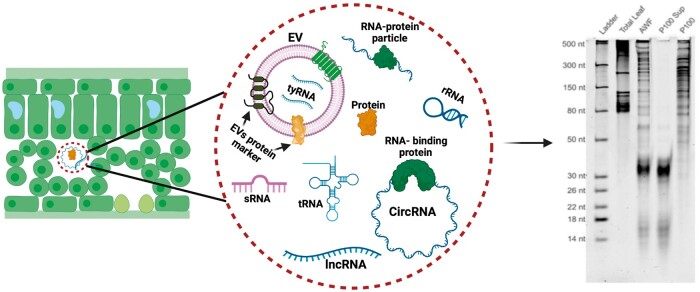RNA is best known in its protein-coding form—middle player in the classical DNA–RNA–protein “central dogma” of molecular biology. However, diverse forms of non-coding RNA continue to be identified as key regulators of gene expression. Notably, small RNAs (sRNAs), such as microRNAs and small interfering RNAs, are well-established regulators of gene expression via RNA silencing. Some sRNAs have even been found to mediate RNA silencing across kingdoms in the context of plant–pathogen interactions, wherein plants produce sRNAs targeting virulence genes within pathogens (Hua et al., 2018), which begs the question of how plant-derived sRNAs are delivered to invading pathogens.
While the apoplast is known to contain secreted RNAs, including sRNAs, these must be protected from degradation by association with RNA-binding proteins and/or localization within membrane-derived extracellular vesicles (EVs). EVs have been shown to contain both proteins and RNAs, and have thus been proposed as an sRNA delivery mechanism for trans-kingdom RNA silencing (Cai et al., 2018; Baldrich et al., 2019; He et al., 2021); however, this has yet to be definitively resolved (Rutter and Innes, 2020).
The study of both apoplastic RNAs and EVs comprises relatively new fields in plant biology and thus presents key questions that are yet to be fully answered, including: (1) which forms of non-coding RNAs are present in the apoplast? (2) Which of these are associated with EVs? (3) Are specific RNAs found inside or outside of EVs? and (4) Are some apoplastic protein–RNA complexes simply “fellow travellers” during the preparation of EVs?
In this issue, Hana Zand Karimi and colleagues (Karimi et al.,2022) have directly addressed these questions in the model plant Arabidopsis thaliana (Arabidopsis) using a combination of EV purification and serial protease and RNase treatments coupled with RNA sequencing. This approach allowed the authors to distinguish between apoplastic RNAs that are inside EVs from those that co-purify, as well as between apoplastic RNAs that are in protein complexes and those inside EVs.
The authors found that, while EVs do contain species of so-called tiny RNAs (tyRNAs) of 11–17 nucleotides in length (Baldrich et al., 2019), the majority of apoplastic sRNAs are instead associated with RNA-binding proteins and are not resident within EVs (see Figure). This suggests that protein–sRNA complexes outside of EVs may be the delivery system in trans-kingdom RNA silencing during plant–pathogen interactions.
Figure.
Plant cells secrete diverse RNA species into the apoplast, including sRNAs, lncRNAs, and circRNAs. Many of these RNAs are located outside of EVs, and in some cases form complexes with RNA-binding proteins. Right panel shows diverse RNAs found within apoplastic wash fluid (AWF) and separation of these into supernatant (P100 Sup) and pellet (P100) following centrifugation at 100,000 × g. Adapted from Karimi et al. (2022), Figure 5.
In addition to sRNAs, the authors also documented the presence of diverse long non-coding RNAs (lncRNAs) in the Arabidopsis apoplast (Karimi et al., 2022). These lncRNAs included circular RNAs (circRNAs), and, as with sRNAs, were also determined to be outside of EVs (see Figure). While largely unstudied in plants, lncRNAs and circRNAs have recently emerged as important regulators of diverse processes in animals; future studies will be critical to determine what role(s) these secreted lncRNAs play in plants.
In summary, Karimi et al. (2022) have documented the diversity of secreted RNAs in the apoplast of Arabidopsis and demonstrated that the majority of sRNAs and lncRNAs are found in protein complexes outside of EVs. These results set new standards for the field and provide a foundation for further characterizing the function of extracellular RNAs in plant immunity and beyond. Notably, non-vesicular extracellular RNAs are only recently coming under study in animals (Tosar et al., 2021), and it will be particularly interesting to see how future work reveals common or divergent functions in plant and animal systems.
References
- Baldrich P, Rutter BD, Karimi HZ, Podicheti R, Meyers BC, Innes RW (2019) Plant extracellular vesicles contain diverse small RNA species and are enriched in 10- to 17-nucleotide “Tiny” RNAs. Plant Cell 31: 315–324 [DOI] [PMC free article] [PubMed] [Google Scholar]
- Cai Q, Qiao L, Wang M, He B, Lin F, Palmquist J, Huang S-D, Jin H (2018) Plants send small RNAs in extracellular vesicles to fungal pathogen to silence virulence genes. Science 360: 1126–1129 [DOI] [PMC free article] [PubMed] [Google Scholar]
- He B, Cai Q, Qiao L, Huang CY, Wang S, Miao W, Ha T, Wang Y, Jin H (2021) RNA-binding proteins contribute to small RNA loading in plant extracellular vesicles. Nat Plants 7: 342–352 [DOI] [PMC free article] [PubMed] [Google Scholar]
- Hua C, Zhao J-H, Guo H-S (2018) Trans-kingdom RNA silencing in plant–fungal pathogen interactions. Mol Plant 11: 235–244 [DOI] [PubMed] [Google Scholar]
- Karimi HZ, Baldrich P, Rutter BD, Borniego L, Zajt KK, Meyers BC, Innes RW (2022) Arabidopsis apoplastic fluid contains sRNA- and circular RNA–protein complexes that are located outside extracellular vesicles. Plant Cell 34: 1863--1881 [DOI] [PMC free article] [PubMed] [Google Scholar]
- Rutter BD, Innes RW (2020) Growing pains: Addressing the pitfalls of plant extracellular vesicle research. New Phytol 228: 1505–1510 [DOI] [PubMed] [Google Scholar]
- Tosar JP, Witwer K, Cayota A (2021) Revisiting extracellular RNA release, processing, and function. Trends Biochem Sci 46: 438–445 [DOI] [PMC free article] [PubMed] [Google Scholar]



